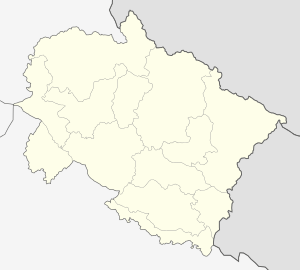Askot
| Askot | |
|---|---|
| Town | |
 Askot  Askot | |
| Coordinates: 29°46′N 80°21′E / 29.77°N 80.35°ECoordinates: 29°46′N 80°21′E / 29.77°N 80.35°E | |
| Country | India |
| State | Uttarakhand |
| District | Pithoragarh |
| Elevation | 1,106 m (3,629 ft) |
| Languages | |
| • Official | Hindi |
| Time zone | IST (UTC+5:30) |
| PIN | 262543 |
| Vehicle registration | UK |
| Website |
uk |
Askot or Askote (Hindi: असकोट) is a small Himalayan town in Pithoragarh district of Uttarakhand in India. It is the part of Kanalichhina development Block and Didihat Tehsil.
The place is also famous for the Askot Musk Deer Sanctuary dedicated to the conservation of Musk deer. Askot lies midway between Pithoragarh to Dharchula road and located on a ridge. 'Kailash-Mansarovar Pilgrimage route from Delhi - Kathgodam - Didihat - Dharchula, passes through Askot.
Historically, the area has been ruled by the Doti Kings of Nepal, Katyuri, Rajbars, Chand, Gorkha and British rulers, though Rajbars continue to be its ceremonial Head. Van Rawats - an endangered tribe of Uttaranchal, inhabits around this area.
Geography
Askot is located at 29°46′N 80°21′E / 29.77°N 80.35°E.[1] It has an average elevation of 1,106 metres (3,629 feet). It is located on Gori Ganga- Kali river geographical divide. Under beautiful natural setting of trees like Pinus, Quercus and Rhododendron, etc., are at the backdrop of Chhiplakot and Panchchuli . The Fertile slopes of Garkha are situated on the front side, and Kali river and mountains of Nepal on its left.
The area around is under heavy underground tunnel mining operations. There are polymetallic mines of copper, zinc, gold, silver and lead deposits.
Origin of name
The name Askot is originated from Assi Kot (Eighty Forts), many of these forts were in Darchula District of Nepal.
History
Pals migrated from Ayodhya to Askot in the Kumaun Hills of Uttrakhand. Pals ruled this area for ages. Previously Askot was under the Doti of Nepal. Later on, Askot was ruled by the a branch of Katyuri kings. After the breakdown of Katyuri Dynasty, King Abhay Pal, the grandson of Katyuri King, Brahm Deo (the Pals original last name was 'Deo' but one of their ancestors called Kunwar Abhay Pal Deo, wrote his surname as Pal and the generations after him followed suit), brought a branch of Katyuri Dynasty, here as the Rajbars, and established the state of Askot, by taking it as a grant from Kings of Doti in 1279 AD.[2]
Later on they came under Chand rulers. From 1279 to 1588 the descendants of Abhay Pal, the Rajbar dynasty ruled over the region,
Administratively, at that time, Askot had two regions-Malla Askot and Talla Askot. This area came under Gorkha control in 1742 but the descendants continued to fight against each other. This family feud continued even after the British defeated the Gorkhas in 1815. Before Askot became Capital, the king used to live at Lakhanpur Kot, near the now Bagarihat (Bagar means river bank) village on the right bank of river Kali. It was situated at the base of Champhachal mountain. The remnants of the fort and market are still here.
Source:
- History of Kumaun
Rajbars of Askot
Rajbar or Rajwar was the official title of the former ruler (feudal kings) Zamidari, of the estate of Askot.[3]
Pals migrated from Ayodhya to Askot in the Kumaun Hills of Uttrakhand. Pals ruled this area for ages. Pals original last name was 'Deo' but one of the ancestors called Kunwar Abhay Pal Deo, wrote his surname as Pal and the generations after him followed suit.
Important tourist places near Askot
Askot Musk Deer Sanctuary ; Ghangdhura ; Chhiplakot Or Najurkot; Chhipladhura lake, Narayan Ashram ;Askot Polymetallic Deposit tunnel Mines ; Bhadigad river ;Rauntishgad river ;Gurjigad river.Confluence of Gori Ganga river with river Kali at Jauljibi.Dhanlekh is a place near Singali is famous place and worshiped by Hindus whole year.
Native Tribes
Van Rawats or Raji or Kirat are native indigenous, ethnic minority community of this area. They inhabit at high altitude. Jamtadi is their nearby village. Their other villages are situated at Ghangdhura ridge.
References
- ↑ Falling Rain Genomics, Inc - Askot
- ↑ Askote Genealogy of Indian Princely States.
- ↑ Pals migrated from Ayodhya to Askot in the Kumaun Hills of Uttrakhand. Pals ruled this area for ages. Pals original last name was 'Deo' but one of the ancestors called Kunwar Abhay Pal Deo, wrote his surname as Pal and the generations after him followed suit. Askot The Imperial Gazetteer of India 1909,v. 6, p. 14.